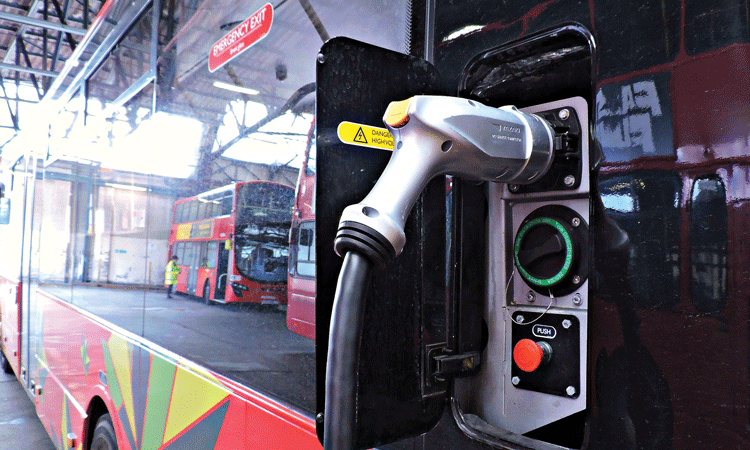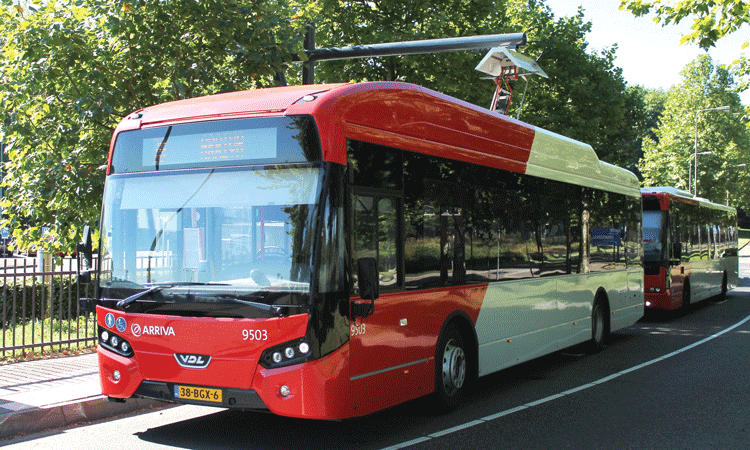The zero emissions race: The epic industry hurdles ahead
- Like
- Digg
- Del
- Tumblr
- VKontakte
- Buffer
- Love This
- Odnoklassniki
- Meneame
- Blogger
- Amazon
- Yahoo Mail
- Gmail
- AOL
- Newsvine
- HackerNews
- Evernote
- MySpace
- Mail.ru
- Viadeo
- Line
- Comments
- Yummly
- SMS
- Viber
- Telegram
- Subscribe
- Skype
- Facebook Messenger
- Kakao
- LiveJournal
- Yammer
- Edgar
- Fintel
- Mix
- Instapaper
- Copy Link
Posted: 2 December 2016 | James Higlett (Arriva), Kyle Testo (Arriva) | No comments yet
Arriva’s drive to become an eco-pioneer is shared by its parent company Deutsche Bahn in their DB2020+ strategy; the aim of which is to preserve resources, reduce emissions and reduce noise pollution. As a responsible pan-European operator, the main aspect of this ambition for Arriva is to reduce their carbon footprint and Zero Emission Vehicle (ZEV) technology is perfectly aligned to assist them in achieving this. In this article, Arriva’s Kyle Testo (Technical Strategy Manager) and James Higlett (Head of Technical Strategy and Innovation) share some of the hidden hurdles they have identified during their investigations to operate environmentally-friendly vehicles.


In the race to produce the most environmentally-friendly and commercially viable buses, many major vehicle manufacturers have committed their own research and development departments to zero emission technologies, such as full electric vehicles or hydrogen fuel cell powered vehicles.
Furthermore, some newer, smaller-scale, specialised vehicle manufacturers are emerging globally to specifically satisfy the rising demands of this rapidly growing Zero Emissions Vehicle (ZEV) market.
The passenger transport industry is on the cusp of a transformational change due to this technology. For the first time in the bus industry, on-vehicle technology is stoking the fire of this transition. Historically the PSV industry has had the innovative technology ‘hand-me-downs’ from its other siblings, such as the HGV industry; but times are changing for the bus.
Due to the operational constraints relating to full electric vehicles, such as the increase in vehicle weight and decrease in operational range, this technology has more naturally emerged in buses first, rather than trucks.
The main hurdle with pioneering the way with a new technology in any industry, especially when it is such a technology game-changer as this, is that you will be the first in line to deal with all of the hidden challenges that are not necessarily obvious up-front prior to implementation. There is a considerable amount of risk involved that is difficult to identify and control.
To follow are some of the hidden hurdles that we have identified.
Hurdle #1: the commercial face-off between ZEVs and diesel
It is a well-known fact that a typical full electric vehicle is approximately twice the price of a Euro 6 diesel powered vehicle; even before including the necessary charging infrastructure to support these new vehicles, or including the cost of replacing the Li-Ion traction battery pack at least once during its complete life-cycle. This makes the justification of the business case for a full electric vehicle rather challenging. However, comparing the two ZEV technology paths available today, it is clear that full electric technology is far closer to becoming commercially viable than hydrogen fuel cell technology. It is also clear that the repair, maintenance and operating costs of a full electric vehicle will be less than that of its diesel counterpart and this is where the technology can gain positive ground over diesel. However, is this positive contributing enough?
Obviously, the key strength of ZEV technologies is the environmental benefit – and this is something that cannot be argued with. However, it is advisable to look at the emissions comparison between vehicles on a well-to-wheel basis and not a tank-to-wheel basis.
It is also important to carefully consider the power source for generating the heating, ventilation and cooling of the passenger saloon on a full electric vehicle, as electrical systems can severely impact the operating range of the vehicle and fitting an auxiliary diesel heating unit defeats the point of a ZEV.
The other aspects to consider are the operational differences – even when comparing a diesel vehicle to a single charge/overnight charge full electric vehicle – which are fairly similar in nature. There are broad differences in passenger carrying capacity; daily operational range; as well as the time required to re-fuel/re-charge that should not be overlooked during the operational planning stage of any ZEV route conversion. In some cases an additional number of ZEVs may be required.
Hurdle #2: the path of least resistance?
The first aspect to consider – following the conclusion that ZEVs are the route you will take – is which technology to utilise. A decision has to be made between two very different vehicle technologies; full electric or hydrogen fuel cell? Each technology is very different; both with their strengths, weaknesses, opportunities and threats. This selection should not be made lightly; plenty of assessment and evaluation needs to go into making an informed decision. Once committed to and invested in either technology, it is very difficult and costly to migrate to the other at a later stage. One thing is obvious, at present and in the near term; the only close to commercially viable solution is full electric. Hydrogen fuel cell may become more competitive if it is adopted in light vehicles first.
Hurdle #3: vendors; spoilt for choice?
With the dawn of this new vehicle technology in our industry, it is apparent that a fleet operator in the market for procuring a ZEV is no longer only limited to vehicles being manufactured and supplied by either the major OEMs or existing manufacturers and body builders. With the dawn of this new type of technology, many smaller niche companies – who don’t necessarily have a historical wealth of experience in bus manufacturing, but instead have technical automotive expertise in electronic control systems, battery technologies and electrical drive-line technologies – have turned this knowledge and their hand to designing and producing ZEVs for the industry. Whilst there is a greater risk involved when partnering with these organisations, some of the innovative technologies and designs that are embedded within their ZEV portfolio may be worth an operator taking a risk on.
Hurdle #4: take the opportunity, swap or stay single?
Once the operator has decided to adopt a ZEV utilising full electric technology, the difficult choices continue. There are various technology tiers within the full electric bus offerings from around the globe, so the operator must decide on the optimum path to pursue. There are three main full electric technology tiers:
Single (overnight) charge
This involves the vehicle being fitted with a large volume of on-board traction batteries, typically around 300kWh. The vehicle is generally charged overnight via a depot located charging point before going out to perform a full day’s service the following day, then returning back to the depot that evening to repeat the same process. This is a fine balance between the vehicle’s ULW, GVW, passenger carrying capacity, traction battery capacity and daily operational range.
Opportunity charge
This involves the vehicle being fitted with a smaller volume of on-board traction batteries, typically between 50 and 100kWh. The vehicle still needs to be charged overnight via depot located charging points in order to balance the battery cells and fully-charge the vehicle. However, these vehicles are designed with the intention of charging-up (topping-up) the vehicles several times during each daily operation via a series of strategically located and street-based charging points.
Robotic battery swap
This involves the vehicles being fitted with traction battery packs of various capacities to suit the operation. The battery packs are modular in design and are tailored to be removable from the vehicle body and chassis structure. Due to the weight of these battery packs, the infrastructure required for this tends to be robotic. This infrastructure is designed to remove, re-charge and re-insert the battery packs as needed. This type of technology is well suited to 24/7 type operations where there is no tolerance for downtime for charging. Owing to its nature, the operator must not only invest in the more complex vehicles and bulky infrastructure, but also in spare battery packs for each vehicle as the batteries in this system are constantly rotated on an exchange basis.
Even within each of these three main technology paths, there are further decisions to make when defining the complete specification of the ZEV solution. These decisions revolve around the type of charging infrastructure selected. After all, ZEVs are only half of a zero emission solution; the charge infrastructure is the other half – without one another there is not a complete zero emission solution. The current options are wide ranging: from regular, fast, ultra or flash charging speeds; to single charge Type 2 or CCS and opportunity charge inductive, standard conductive and inverted conductive. The possible combinations are numerous; in the end, each solution is heavily tailored. Standardisation within the industry is very much needed and this is taking place behind the scenes.
Hurdle #5: remain cellular or take a dose of super-caps?
When looking into energy storage mediums for electric vehicles, there are two tiers of technology – battery cells or super/ultra-capacitors. The properties and characteristics of these types differ greatly. Super-capacitor weaknesses are that they are heavier and larger per kWh (with much lower charge density) and are significantly more expensive per kWh when compared to battery cells. Their main strength is that they have an extremely long life, supposedly with an infinite life-cycle, so may not need to be replaced in the lifetime of the vehicle. Battery cells are basically the exact opposite of this. Lighter and smaller per Kwh and much cheaper per kWh, their main downfall is that they do degrade over time and will need to be replaced after a certain number of charge and discharge cycles; this number is governed by the specific chemistry.


A conductive opportunity charging vehicle in the Netherlands
Hurdle #6: which chemistry appeals to you?
There are many available chemical make-ups of ‘wet’ Lithium-Ion battery cells, all of which are suitable for specific industries and applications. For heavy vehicle automotive applications there are three prominent chemistries being applied to FEVs.
There is a great deal of research and development occurring behind the scenes to further improve the properties of these ‘wet’ Lithium-Ion-based battery cells by improving their kWh charge density whilst attempting to reduce their cost. However, alternative ‘dry’ battery cell technologies are also being assessed and evaluated behind the scenes and these could form the future of energy storage mediums for full electric vehicles. Examples of these are Lithium-Polymer (Li-Po) and solid state cells.
Hurdle #7: what drives your success?
Once the optimum energy storage medium has been identified for the vehicle, the same has to be done for the drivetrain of the vehicle. On full electric vehicles the drivetrain options available are:
- Rear portal or hypoid diff axle combined with a centrally mounted electrical traction motor
- Bespoke rear axle, combining a solid axle and 2x in-hub mounted electrical traction motors.
Within these two sub-categories are many models and combinations available from various manufacturers. Each variation will have different levels of performance characteristics in areas such as power, torque, weight, size, efficiency, noise, complexity, safety, cost and regenerative capability. It is important to select the right drivetrain for the right route, operation, topography and vehicle.
The overall efficiency of the vehicle depends on the combined efficiency, properties, statistics and capabilities of the energy storage medium, traction motor(s), battery management system (BMS), as well as the vehicle chassis and body design opted for.
Hurdle #8: the necessary evil of the equation
When looking at a ZEV solution, the most important thing to recognise is that the vehicles are only half of the solution. The remaining half of the solution is the acquisition, installation and commissioning of the new infrastructure that is required to support this new generation of PSV.
The infrastructure to re-fuel diesel vehicles is something that operators have had to spend very little on in order to purchase, install, maintain and upgrade, compared to what is now required for re-fuelling and re-charging infrastructure for hydrogen fuel cell and full electric vehicles. This new infrastructure is needed in addition to the existing diesel re-fuelling infrastructure that will still be required for the existing diesel vehicles. When comparing the new infrastructure required to that of diesel infrastructure, it is extremely costly; highly complex; requires a large area of free space to be dedicated to it; and can introduce new safety hazards and risks into the workplace.
For single charge infrastructure this will consist of several static charge points that are located at the operational facility where the vehicles are based; normally a single charge point can charge one or two vehicles at any given time. The actual charge points – when compared to the other categories of ZEV infrastructure – are relatively inexpensive to purchase. However, the main (and hidden) cost is in fact getting the level of power supply required to the door of the site. The cost and lead time to do this can be literally eye-watering even in the best of cases.
For opportunity charge infrastructure, as previously stated, depot located charging infrastructure is still required. On top of this, strategically located street-based charging points are also required. The opportunity charge points are vastly more expensive than single charge points – mainly due to their size, substantial power rating and difficult installation.
The main complexity, other than cost, relating to this type of charging infrastructure is that there is currently no clear definition as to which organisation is obliged to invest in it; apply for the planning permission; own it and maintain it. Should this be the PTA, the PTO or an energy supplier? In an ideal world this infrastructure should be shared between the different PTOs and all PSVs in a city. Therefore, PTO ownership of this infrastructure is not the optimum business model and is risky.
For hydrogen fuel cell re-fuelling infrastructure, this will consist of either a hydrogen bulk storage and delivery system or a hydrogen electrolysis station linked to a bulk storage and delivery system; both located at the operational facility. The main difference between these two types is that the first does not generate the hydrogen. The hydrogen fuel needs to therefore be procured and transported to the site on a regular basis, much like diesel currently; whereas the hydrogen electrolysis station is able to generate the hydrogen fuel directly from water. The second option is obviously the optimum and most appealing type, however, the cost of this type of infrastructure is currently extraordinary and maybe difficult to justify at this point in time. It really depends on the cost of the procurement and transportation of the hydrogen fuel in a specific region.
Hurdle #9: is the current network able to support your modern bandwidth?
Perhaps the greatest challenge for full electric ZEVs is whether the local energy grid is robust enough to support the electrical energy demands of such a solution. When piloting and trialling single figure fleets of full electric vehicles, the issues encountered are fairly minimal and straight forward to deal with. The real challenge is evident when you start to look further ahead to the future of the passenger transport industry; assessing and evaluating the potential requirements to support an entire operational ZEV fleet or ZEV vehicle depot. The magnitude of this challenge varies from country-to-country and region-to-region depending on the level of maturity of the local energy grid. – However, this is and will be a common issue for all countries and regions; the solution to which will be predominantly driven with a political steer.
The finish line
Without a doubt the future of the global passenger transport industry will be focused around ZEVs. Our global environment and the quality of the air that our population breathes will need to improve. With an ever-growing global population cities will become larger and more densely populated. Many countries, cities and authorities are currently extremely focused on making sure that they play an active part in this agenda: they, like us, want to be responsible and form part of the solution rather than part of the problem.
All ZEV technologies will no doubt have their part to play in the complete solution that lies ahead. Naturally, some of these technologies will play a much larger role than others due to differences in commercial viability, maturity, capability and also appeal.
It is and will be an exciting period of time to be actively involved in the passenger transport industry. The industry, I believe, is on the cusp of a transformational change. Whether it be ZEV technologies or autonomous vehicle technologies, for the first time in its long history the passenger transport industry will be pioneering the way with wide-scale adoptions of these ground-breaking technologies. It is critical, more than ever, for PTAs, PTOs and OEMs to break down any existing barriers between them and focus on forging close and transparent partnerships. It is these close partnerships that will drive the technologies and environmental objectives forward to success.




Issue
Issue 6 2016
Related modes
Bus & Coach








